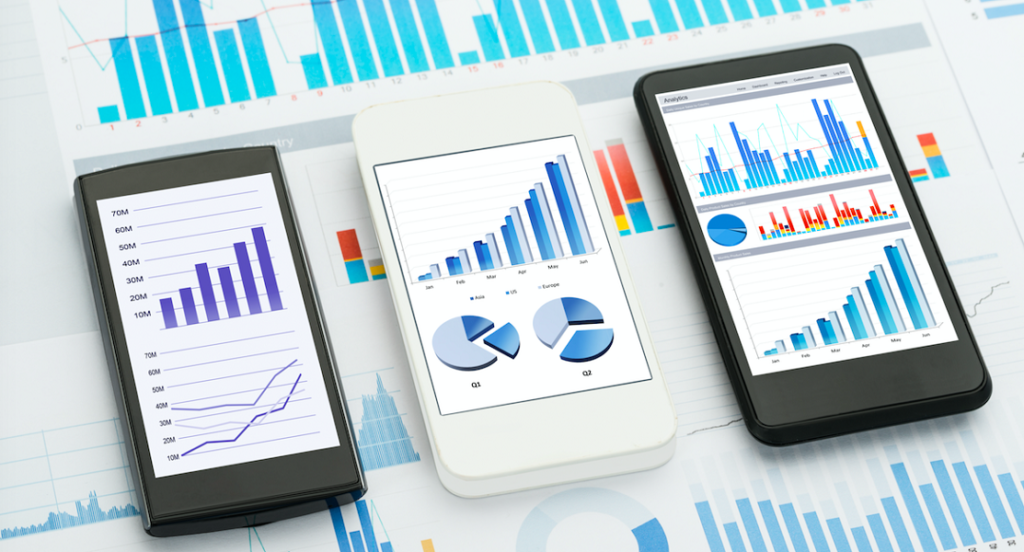After a successful launch of the service on iOS and Android, any company needs to understand how to evaluate a mobile app in terms of efficiency for its further promotion. There is no universal formula for performing such a difficult task, but in this article, we’ll show you which metrics and features to focus on first.
What indicators of the effectiveness of a mobile app should be guided by:
- The number of downloads and the number of registrations. Depending on how often users download a mobile app, its ranking in the search engines of the App Store and Play Store changes. The more downloads an app has, the higher it appears in the search results and the larger the audience it covers. The number of signups, on the other hand, speaks to how well a service engages people with its core functions.
- Activity in the app. To evaluate this app metric, it’s important to track how many unique users open it during the day (DAU), week (WAU), and month (MAU). We also pay attention to the number of sessions in the app for a certain period, the average length of these sessions, and the so-called engagement rate (when DAU is divided by WAU or MAU).
- Users’ engagement is dictated by how actively they interact with key features of the mobile app. To get your audience interested in the beginning, you need to walk them through a well-tuned onboarding process. And after the first session, customer engagement can be increased through notifications, gamified app tours, emails, etc.
- Average session length. This metric is determined by dividing the total length of all sessions of the app for a specific period by the number of sessions. The metric plays an extremely important role in terms of advertising placement in the service.
- Customer retention rate. This parameter characterizes the total number of users who open the app on a regular basis. On average, only 20% of users return to a mobile app after its first launch, so by increasing this metric even by 2-3%, a company can achieve significant profit growth.
- Virality. If an app is highly viral, people are more likely to tell their friends and family about it in person or through different communication channels, be it messengers, social networks, or forums.
- Customer churn rate. By tracking this metric, we can see how many users have uninstalled or completely stopped interacting with the app. It’s really vital to the success of the service because even a slight increase in churn can lead a company to complete collapse in the long term.
- Metrics to measure monetization. To assess the effectiveness of app monetization, we take into account the number of paying users, transactions over a certain period, lifetime value of users, number of transactions, average income per customer, and some other metrics.
- Customer Lifetime Value. Lifetime value shows the average profit received from one client for the entire period of using the app.
- Return on advertising investments. To evaluate the app in this context, we focus on metrics like cost per install, virality index (the number of users who became interested in the app through recommendations), and customer acquisition cost (CAC).

Useful services for mobile analytics

- AppMetrica. This free tool from Yandex allows you to track data on the main service metrics, traffic sources, crash statistics, as well as launch, analyze and optimize advertising campaigns in the app.
- Firebase Analytics. It is a Google platform that combines app development and analytics tools. The service works based on Google Analytics reports, allows you to use Cloud Messaging technology of push notifications, and has functionality for conducting A/B tests in Android apps.
- Flurry Analytics. One of the popular free analytics platforms through which you can collect data both about users themselves and about events or actions initiated by them. Besides that, here you have access to analytics on geolocation, types of devices, and interests of the audience.
- AppAnnie. It’s an analytical service that is useful for collecting data about an app at all stages of its development. The platform helps to research competing services, assess the market situation, monitor the number of downloads, advertising campaigns, customer engagement, and more.
Conclusion
To make the best possible business decisions, assessing app performance must be based on a variety of factors. The above metrics are key for such an assessment, and if you can combine them into the big picture, it will be much easier for you to identify the aspects of the app that require the most of your attention.
By the way with all the mobile apps advantages for business you can read our updated article!




